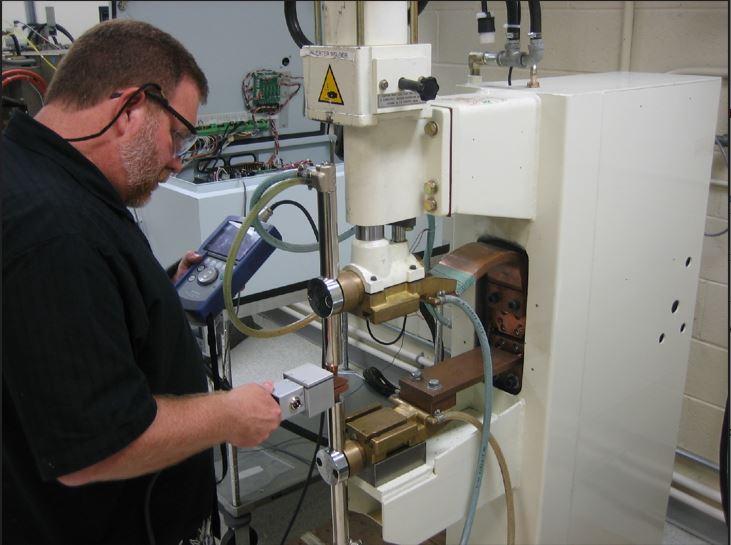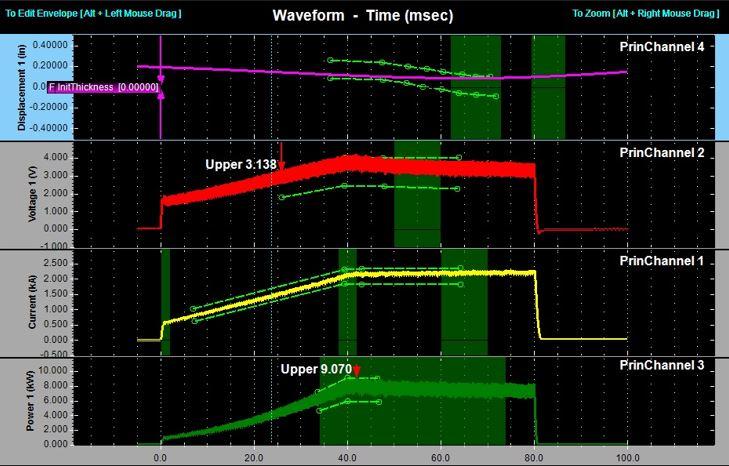Senior Manager, Product Engineering and Applications
- FMA
- The Fabricator
- FABTECH
- Canadian Metalworking
Categories
- Additive Manufacturing
- Aluminum Welding
- Arc Welding
- Assembly and Joining
- Automation and Robotics
- Bending and Forming
- Consumables
- Cutting and Weld Prep
- Electric Vehicles
- En Español
- Finishing
- Hydroforming
- Laser Cutting
- Laser Welding
- Machining
- Manufacturing Software
- Materials Handling
- Metals/Materials
- Oxyfuel Cutting
- Plasma Cutting
- Power Tools
- Punching and Other Holemaking
- Roll Forming
- Safety
- Sawing
- Shearing
- Shop Management
- Testing and Measuring
- Tube and Pipe Fabrication
- Tube and Pipe Production
- Waterjet Cutting
Industry Directory
Webcasts
Podcasts
FAB 40
Advertise
Subscribe
Account Login
Search
A resistance weld process monitoring Q&A
Discovering the value of a weld monitor in your shop
- By Mark Boyle
- December 20, 2022
- Article
- Assembly and Joining

A resistance weld monitor can measure electric current during the weld, voltage between electrodes, electrode force, and electrode movement.
1. How can I find the cause of inconsistent resistance welding results?
Process consistency is a common challenge in resistance welding. A number of things can go wrong, all caused by variations in one or more of these areas: equipment performance, material properties, and process settings.
To find the culprit, start by recording weld process parameters with a weld monitor and examining the results. An experienced, well-trained operator can detect welding problems and make educated guesses about their causes, but without the data from a weld monitor, that operator is largely running blind.
2. What process parameters can be measured by a weld monitor?
A resistance weld monitor can measure electric current during the weld, voltage between electrodes, electrode force, and electrode movement.
Basic models output a numeric aggregated value (minimum or maximum) for one or more parameters. More advanced monitors can capture and analyze the entire high-resolution waveform of every parameter. Waveforms provide much more useful information about the dynamic weld process than do aggregated values. For example, waveforms can reveal sparking caused by inconsistent fit-up, loose welding machine hardware, and inconsistent timing between application of mechanical force and electrical power.
3. What do these parameters tell me about the weld?
Resistance welding is achieved by applying heat and pressure over time. Heat is supplied by passing current through the electrodes and weldment. Pressure is supplied by squeezing the weldment between two electrodes at a predetermined force. The time profile, or rate at which current and pressure are applied, can affect the weld result.
Heat and pressure cannot be measured directly. But they are the consequence of the current through the parts, voltage across the electrodes, and force applied by the weld head. Other electrical parameters, like power and resistance, can be derived from these measurements. In addition, the weld process causes a small movement, or displacement, of the electrodes that can reveal whether the weld has progressed as expected.
A change in any of these the parameters could indicate problems in the welding process, like improper alignment, dirt and debris, change in material, and change in coating.
4. Can a weld monitor determine a good or a bad weld?
The monitor, with its resultant values and waveforms, does not indicate whether a weld is bad or good. It can, however, compare the most recent weld to a known good weld. If the parameters are similar, it is passed as good; if outside the range, it is flagged as different. Different is often considered bad in a production setting, and the part would be flagged for rework or scrapped.
To determine the range of acceptable values or limits, a user will run a design of experiments using different weld equipment settings that will affect weld quality. Waveforms are recorded and reviewed with weld quality results. At the end of the study, upper and lower parameter limits can be set so that the range includes good welds and excludes bad welds. The optimal limits setting should avoid the acceptance of too many false positives—that is, welds that generate readings inside the limits but fail welding quality specifications. Finding the ideal parameter limits is time-consuming, but the result is process settings that will identify a good weld within statistical limits. For critical welds, this is the de facto procedure to follow for such products as safety components or medical devices.
5. What else can weld monitors be used for?
In addition to quality assurance, weld monitors are used for:

Advanced weld monitors can capture and analyze the entire high-resolution waveform of every parameter.
- Identifying correct settings during process development. The stability of the settings can be compared for process optimization.
- Maintenance troubleshooting. The shape of the waveform captured by a weld monitor can indicate problems with material properties and process setting changes and alert the users to equipment malfunctions.
- Equipment certification. A weld monitor can verify that equipment is running as expected. If you programmed a 2,000-amp weld for 10 ms, you want to be sure that the power supply delivers as expected.
- Data storage. When a weld monitor is connected to a manufacturing execution system, the weld values it has collected for a specific manufactured part can be stored.
6. Where is the weld monitor data stored, and how can I use it?
Data can be stored locally in the process monitor or on a networked server, either on premise or in the cloud. Modern, high-end monitors have software that stores recorded values in a database server. This database can be accessed and used by analytical statistical process control (SPC) software and overall equipment efficiency (OEE) programs.
Production managers, process engineers, and operators can use stored data to make informed decisions about the production process that affect product quality, throughput, and cost.
7. Can this data be used for artificial intelligence or machine learning algorithms?
Indeed, it can. Artificial intelligence (AI) and machine learning (ML) are being applied in the welding field to create smart adaptive limits and to predict weld quality.
The AI/ML algorithms look for trends in the recorded data that may not be seen through standard graph analysis. In addition, AI/ML tools can generate many data features from process waveforms that can be used to spot subtle details about the welding process. While the sheer volume of data can overwhelm garden-variety SPC software tools, the data can be handled easily by modern ML algorithms running on inexpensive computers.
The AI/ML programs go beyond the simple instantaneous limits discussed in question No. 4. They adapt limits during the welding process, allowing for external fluctuations that occur naturally over time, such as ambient temperature and electrode exchange. These smart adaptive limits allow for higher throughput and better quality.
AI/ML may be able to finally answer the question, “Was that last weld good or bad?” and provide a means for weld quality prediction.
About the Author
Mark Boyle
1820 S. Myrtle Ave.
Monrovia, CA 91016
(626)-303-5676
Related Companies
subscribe now

The Fabricator is North America's leading magazine for the metal forming and fabricating industry. The magazine delivers the news, technical articles, and case histories that enable fabricators to do their jobs more efficiently. The Fabricator has served the industry since 1970.
start your free subscription- Stay connected from anywhere

Easily access valuable industry resources now with full access to the digital edition of The Fabricator.

Easily access valuable industry resources now with full access to the digital edition of The Welder.

Easily access valuable industry resources now with full access to the digital edition of The Tube and Pipe Journal.
- Podcasting
- Podcast:
- The Fabricator Podcast
- Published:
- 04/16/2024
- Running Time:
- 63:29
In this episode of The Fabricator Podcast, Caleb Chamberlain, co-founder and CEO of OSH Cut, discusses his company’s...
- Trending Articles
Tips for creating sheet metal tubes with perforations

JM Steel triples capacity for solar energy projects at Pennsylvania facility

Are two heads better than one in fiber laser cutting?

Supporting the metal fabricating industry through FMA

Omco Solar opens second Alabama manufacturing facility

- Industry Events
16th Annual Safety Conference
- April 30 - May 1, 2024
- Elgin,
Pipe and Tube Conference
- May 21 - 22, 2024
- Omaha, NE
World-Class Roll Forming Workshop
- June 5 - 6, 2024
- Louisville, KY
Advanced Laser Application Workshop
- June 25 - 27, 2024
- Novi, MI


























